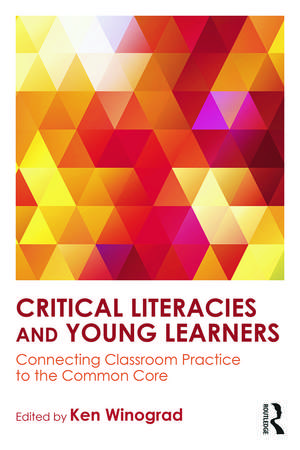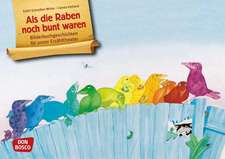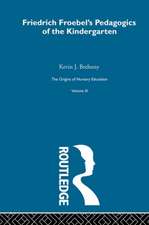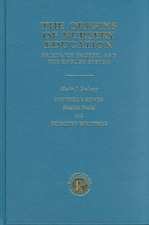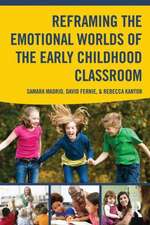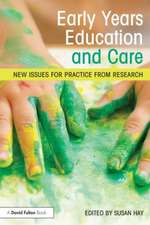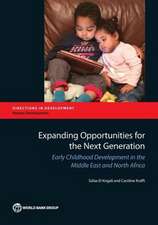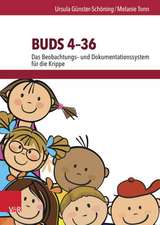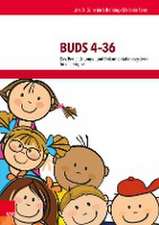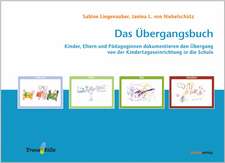Critical Literacies and Young Learners: Connecting Classroom Practice to the Common Core
Editat de Ken Winograden Limba Engleză Paperback – 25 sep 2014
Part I provides several orienting frameworks on critical literacy, giving specific attention to its relationship to the Common Core Standards. Part II features chapters describing critical literacy in practice, grouped in 4 thematic clusters: using texts from popular culture and everyday life; focusing on issues-oriented texts and cultural identity; functional linguistic analysis of texts; interdisciplinary that engage young learners in critical social action projects. Part III addresses the micro-political contexts of teaching critical literacy.
| Toate formatele și edițiile | Preț | Express |
|---|---|---|
| Paperback (1) | 477.56 lei 6-8 săpt. | |
| Taylor & Francis – 25 sep 2014 | 477.56 lei 6-8 săpt. | |
| Hardback (1) | 1218.12 lei 6-8 săpt. | |
| Taylor & Francis – 16 sep 2014 | 1218.12 lei 6-8 săpt. |
Preț: 477.56 lei
Nou
Puncte Express: 716
Preț estimativ în valută:
91.38€ • 95.42$ • 75.46£
91.38€ • 95.42$ • 75.46£
Carte tipărită la comandă
Livrare economică 15-29 aprilie
Preluare comenzi: 021 569.72.76
Specificații
ISBN-13: 9780415743228
ISBN-10: 0415743222
Pagini: 240
Ilustrații: black & white illustrations, figures
Dimensiuni: 152 x 229 x 15 mm
Greutate: 0.34 kg
Ediția:New.
Editura: Taylor & Francis
Colecția Routledge
Locul publicării:Oxford, United Kingdom
ISBN-10: 0415743222
Pagini: 240
Ilustrații: black & white illustrations, figures
Dimensiuni: 152 x 229 x 15 mm
Greutate: 0.34 kg
Ediția:New.
Editura: Taylor & Francis
Colecția Routledge
Locul publicării:Oxford, United Kingdom
Cuprins
Preface
Part I: Overview of Critical Literacy and Common Core Standards
Chapter 1: Critical Literacy, Common Core Standards and Young Children: Imagining a Synthesis of Educational Approaches
Ken Winograd
Chapter 2: The Four Corners Not Enough: Critical Literacy, Education Reform, and
the Shifting Instructional Sands of the Common Core State Standards
Wayne Au and Barbara Waxman
Part II: Teachers and Young Children Doing Critical Literacy
A. Using Texts from Popular Culture and Everyday Life
Chapter 3: Show Mum You Love Her: Taking a New Look at Junk Mail
Jennifer O’Brien
Chapter 4: Using the Everyday to Engage in Critical Literacy with Young Children
Vivian Vasquez
B. Focusing on Issues and Cultural Identity
Chapter 5: Using Theatre of the Oppressed to Foster Critical Literacy
Carol Lloyd Rozansky with Caroline Thorpe Santos
Chapter 6: Talking with Trolls: A Creative and Critical Engagement with Students'
Nature-Naiveté
Simon Boxley, Helen Clarke, Sharon Witt, and Victoria Dewey
Chapter 7: Out of the Box: Critical literacy in a First-Grade Classroom
Christine H. Leland and Jerome C. Harste, with Kimberly R. Huber
Chapter 8: Using Read-Alouds with Critical Literacy Literature in K-3 Classrooms
Wendy B. Meller, Danielle Richardson, and J. Amos Hatch
C. Applying Critical Functional Linguistics
Chapter 9: Teaching Social Studies and Critical Linguistics to Language Learners: Complexities, Tensions, and Opportunities
Kathryn McIntosh Ciechanowski
Chapter 10: Critical Linguistics in the Early Years: Exploring Language Functions through Sophisticated Picture Books and Process Drama Strategies
Beryl Exley and Karen Dooley
D. Engaging Young Learners in Critical Social Action Projects
Chapter 11: Critical Literacy Finds a ‘Place’: Writing and Social Action in a Low-
Income Australian Grade 2/3 Classroom
Barbara Comber and Pat Thomson, with Marg Wells
Chapter 12: Exploring Child Labor with Young Students
Kate Lyman
Part III: Understanding the Micro-Political Contexts of Teaching Critical Literacy
Chapter 13: Developing Critical Consciousness: Children and Teachers Reading Wide Awake
Patrick Shannon
Chapter 14: We Teach Who We Are: Reflections on Teaching for Social Justice with Young Children
Dale Weiss
Part IV: Bringing it All Together
Chapter 15: Critical Literacy and the Common Core: Resolving Tensions and Enhancing Student Engagement
Ken Winograd
Supplemental Resources: An Annotated Short List
About the Authors
Index
Part I: Overview of Critical Literacy and Common Core Standards
Chapter 1: Critical Literacy, Common Core Standards and Young Children: Imagining a Synthesis of Educational Approaches
Ken Winograd
Chapter 2: The Four Corners Not Enough: Critical Literacy, Education Reform, and
the Shifting Instructional Sands of the Common Core State Standards
Wayne Au and Barbara Waxman
Part II: Teachers and Young Children Doing Critical Literacy
A. Using Texts from Popular Culture and Everyday Life
Chapter 3: Show Mum You Love Her: Taking a New Look at Junk Mail
Jennifer O’Brien
Chapter 4: Using the Everyday to Engage in Critical Literacy with Young Children
Vivian Vasquez
B. Focusing on Issues and Cultural Identity
Chapter 5: Using Theatre of the Oppressed to Foster Critical Literacy
Carol Lloyd Rozansky with Caroline Thorpe Santos
Chapter 6: Talking with Trolls: A Creative and Critical Engagement with Students'
Nature-Naiveté
Simon Boxley, Helen Clarke, Sharon Witt, and Victoria Dewey
Chapter 7: Out of the Box: Critical literacy in a First-Grade Classroom
Christine H. Leland and Jerome C. Harste, with Kimberly R. Huber
Chapter 8: Using Read-Alouds with Critical Literacy Literature in K-3 Classrooms
Wendy B. Meller, Danielle Richardson, and J. Amos Hatch
C. Applying Critical Functional Linguistics
Chapter 9: Teaching Social Studies and Critical Linguistics to Language Learners: Complexities, Tensions, and Opportunities
Kathryn McIntosh Ciechanowski
Chapter 10: Critical Linguistics in the Early Years: Exploring Language Functions through Sophisticated Picture Books and Process Drama Strategies
Beryl Exley and Karen Dooley
D. Engaging Young Learners in Critical Social Action Projects
Chapter 11: Critical Literacy Finds a ‘Place’: Writing and Social Action in a Low-
Income Australian Grade 2/3 Classroom
Barbara Comber and Pat Thomson, with Marg Wells
Chapter 12: Exploring Child Labor with Young Students
Kate Lyman
Part III: Understanding the Micro-Political Contexts of Teaching Critical Literacy
Chapter 13: Developing Critical Consciousness: Children and Teachers Reading Wide Awake
Patrick Shannon
Chapter 14: We Teach Who We Are: Reflections on Teaching for Social Justice with Young Children
Dale Weiss
Part IV: Bringing it All Together
Chapter 15: Critical Literacy and the Common Core: Resolving Tensions and Enhancing Student Engagement
Ken Winograd
Supplemental Resources: An Annotated Short List
About the Authors
Index
Notă biografică
Ken Winograd is Associate Professor, College of Education, Oregon State University, USA.
Recenzii
"'Defying Piaget's cognitive theory position that younger learners are unable to think abstractly in the lower stages of development, the critical literacy researchers Winograd (Oregon State Univ.) assembled present actual classroom practices designed to bring critical thinking skills to curricular practice while meeting the Common Core Standards requirements ...Overall, Winograd and his associates articulate ways to teach meaningfully and effectively through the standardization of the Common Core. Summing Up: Recommended. Upper-division undergraduates through professionals and practitioners."- D. D. Bouchard, Crown College, for CHOICE, August 2015
"Finally, a book for early childhood educators that demonstrates the wide variety of approaches to living-out critical literacy with young children—that there is not ‘one’ right way to do it —and situates the numerous classroom examples in a larger discussion of the current socio-political educational climate, which emphasizes testing and ‘basic literacy skills.’"- Candace R. Kuby, University of Missouri, USA
"This volume of seminal and new work in critical literacy gives readers a view of where the field has been and contains exciting new research and voices showing us where critical literacy in early childhood is headed."-Tasha Tropp Laman, University of South Carolina, USA
"Finally, a book for early childhood educators that demonstrates the wide variety of approaches to living-out critical literacy with young children—that there is not ‘one’ right way to do it —and situates the numerous classroom examples in a larger discussion of the current socio-political educational climate, which emphasizes testing and ‘basic literacy skills.’"- Candace R. Kuby, University of Missouri, USA
"This volume of seminal and new work in critical literacy gives readers a view of where the field has been and contains exciting new research and voices showing us where critical literacy in early childhood is headed."-Tasha Tropp Laman, University of South Carolina, USA
Descriere
This text shows how critical literacy is do-able with young children, even in today’s context of Common Core Standards, mandates, and pressures, and honors the sophisticated and complex social theorists that young children are.
